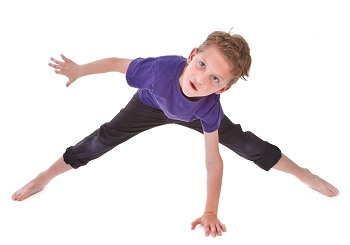 Acro dance, or just acro, as it’s commonly called by dancers and instructors, is a style of dance that combines classical technique with fluid acrobatic movements. It is very physically demanding and requires strength, control and flexibility.
Acro dance, or just acro, as it’s commonly called by dancers and instructors, is a style of dance that combines classical technique with fluid acrobatic movements. It is very physically demanding and requires strength, control and flexibility.
If you are already a dancer or gymnast, you may be considering adding acro to your repertoire. If you’re a new student, you may be curious about what is involved. Here’s what to expect at your first class so that you can be prepared.
What Is Acro Dance?
Acro started showing up in America in the early 1900s in vaudeville acts. Dance and acrobatic acts had been performed separately in vaudeville for many years before it started becoming popular to combine the two.
The style evolved and today the foundation is strongly rooted in classical ballet, which is where it gets the precise, fluid motion it’s known for. Accomplished dancers move smoothly and gracefully between dance and acrobatics, unlike the jerky movements of a gymnast. It is important to note that the style is dance first, acrobatics second. A gymnastic floor exercise is not acro dance, because the dance moves play such a small role. In true acrobatics dance, the dance portion will be significantly greater than the acrobatics moves.
Experience In Dance, Acrobatics, Both?
Individuals with some experience in both dance and acrobatics will have the easiest time learning acro, but it is not necessary.
Experienced dancers who are physically fit and flexible will be able to learn the acro side with plenty of practice that includes tumbling and passes on mats spotted by a professional instructor. The core of this style is based on classical techniques from ballet, lyrical, jazz and modern dance.
Gymnasts with no dance training may find it helpful to take an additional ballet class to learn the fundamentals of the classical techniques.
No Experience? When To Start
It is generally recommended that children start classes at age 7. Although they can be started at any age after that, the training creates a strong foundation that can help them learn new styles as they grow. Younger children also tend to be more flexible and so have an easier time mastering the acrobatics portion.
What To Wear
Due to the tumbling nature, skin tight clothes such as a leotard and leggings or shorts are generally recommended. Skirts or loose fitting shirts that will fall over the student’s face pose a safety hazard.
The tumbling and pass portion of practice on mats is often done barefoot, but dancers will use a jazz shoe or sometimes even a foot thong to protect the foot and provide cushion.
If you are curious about acro dance classes, many studios offer a free consultation and trial class to see if it’s something you are interested in.
No comments:
Post a Comment